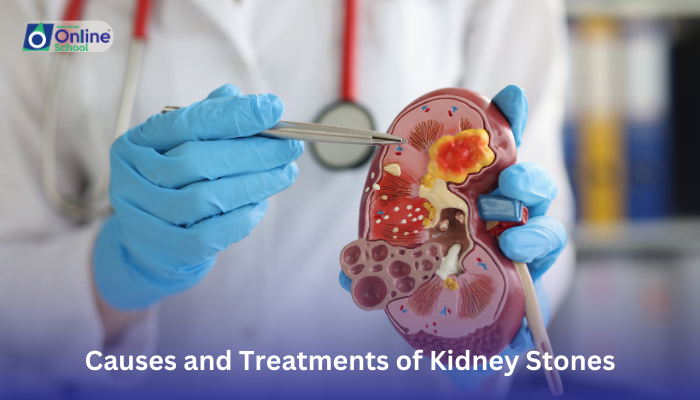
Learning Outcomes
i. Identify the various types of kidney stones and their composition.
ii. Understand the factors that contribute to the formation of kidney stones.
iii. Recognize the symptoms of kidney stones.
iv. Explain the different methods used for the treatment of kidney stones.
v. Discuss strategies for preventing the formation of kidney stones.
Introduction
Kidney stones are hard deposits that form in the kidneys. They are caused by a buildup of certain substances in the urine, such as calcium, oxalate, uric acid, or phosphate. Kidney stones can range in size from a few millimeters to several centimeters. Small stones may pass through the urinary tract without causing any symptoms. However, larger stones can cause severe pain and block the flow of urine.
i. Types of Kidney Stones
The four main types of kidney stones are:
Calcium stones: These are the most common type of kidney stone, accounting for about 70-80% of all cases. They are formed from calcium oxalate, calcium phosphate, or a combination of both.
Struvite stones: These stones are less common than calcium stones and account for about 10-15% of all cases. They are formed from magnesium ammonium phosphate and are often associated with urinary tract infections.
Uric acid stones: These stones account for about 5-10% of all cases. They are formed from uric acid, which is a waste product of purine metabolism. Purines are found in certain foods, such as red meat, organ meats, and seafood.
Cystine stones: These are the rarest type of kidney stone, accounting for about 1-2% of all cases. They are caused by a genetic disorder that causes the body to excrete too much cystine, an amino acid, in the urine.
ii. Factors Contributing to Kidney Stone Formation
Several factors can increase the risk of developing kidney stones. These include:
Dehydration: Not drinking enough fluids can lead to concentrated urine, which increases the risk of stone formation.
Diet: A diet high in salt, animal protein, and fructose can increase the risk of kidney stones.
Medical conditions: Certain medical conditions, such as obesity, gout, and hyperparathyroidism, can also increase the risk of kidney stones.
Family history: Having a family history of kidney stones increases your risk of developing them yourself.
iii. Symptoms of Kidney Stones:
The most common symptom of kidney stones is severe pain in the lower back, abdomen, or groin. The pain may come and go in waves and may be accompanied by nausea, vomiting, blood in the urine, and frequent urination.
iv. Treatment of Kidney Stones
The treatment for kidney stones depends on the size and location of the stone. Small stones may pass through the urinary tract on their own. However, larger stones may require medical treatment.
Pain medication: Pain medications can be used to relieve the pain caused by kidney stones.
Extracorporeal shock wave lithotripsy (ESWL): ESWL is a non-invasive procedure that uses shock waves to break up kidney stones into smaller pieces that can pass through the urinary tract.
Ureteroscopy: Ureteroscopy is a procedure that uses a thin, flexible tube with a camera and light source to remove kidney stones.
Percutaneous nephrolithotomy (PCNL): PCNL is a surgical procedure that involves making a small incision in the back to remove kidney stones.
v. Prevention of Kidney Stones
There are several things you can do to reduce your risk of developing kidney stones:
Drink plenty of fluids: Aim to drink at least eight glasses of water per day.
Eat a healthy diet: Eat a diet that is low in salt, animal protein, and fructose.
Avoid certain medications: Avoid taking certain medications that can increase the risk of kidney stones, such as high-dose vitamin C supplements and certain antibiotics.
Control your weight: If you are overweight or obese, losing weight can help reduce your risk of kidney stones.
Kidney stones can be a painful and disruptive condition. However, with proper treatment and prevention, you can reduce your risk of developing them and manage their symptoms effectively.